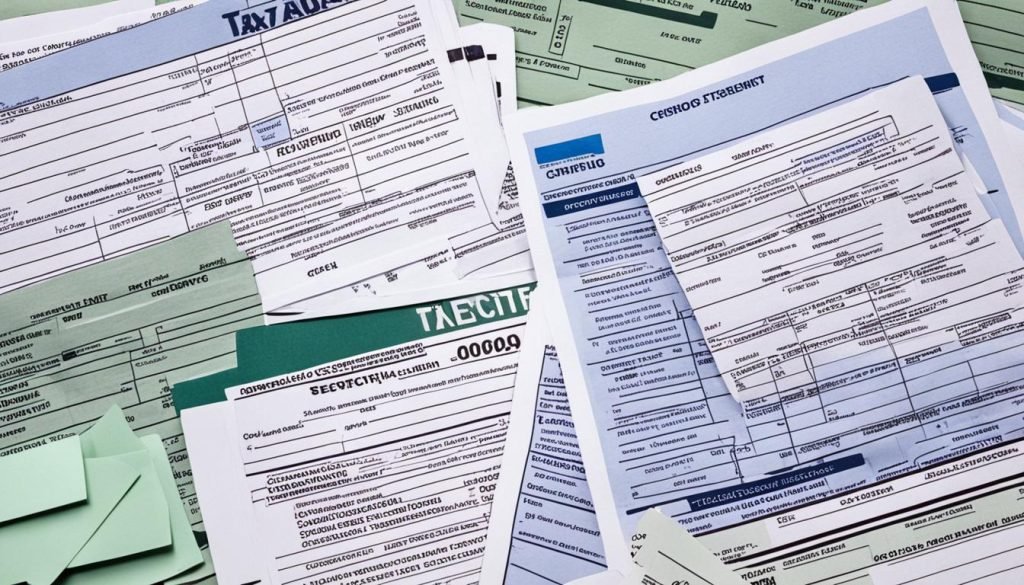For businesses in the United States, understanding tax credits and deductions is key. These tools help lower taxes, making companies more profitable. Tax credits directly cut down the taxes owed. Deductions reduce the income subject to taxes, giving businesses a break and saving money.
By learning about different tax incentives, business owners can use these breaks to boost their finances. This knowledge helps them make smart tax strategies.
Key Takeaways
- Tax credits directly lower the amount of taxes owed.
- Tax deductions decrease taxable income, leading to potential savings.
- Understanding the differences can optimize tax strategies.
- Various tax incentives are available to support businesses.
- Effective documentation is key to claiming benefits.
Understanding the Basics of Tax Credits and Deductions
Tax credits and deductions are key to managing a business’s finances. They can lead to big savings. Tax credits directly reduce the tax owed by a dollar-for-dollar amount. This makes them attractive for businesses wanting to boost profits.
Tax deductions work differently. They lower taxable income, not just the tax amount. For example, if a business makes $100,000 and deducts $20,000, its taxable income drops to $80,000. This could put the business in a lower tax bracket, reducing the tax owed.
Choosing between the standard deduction and itemized deductions depends on which is more beneficial. Itemized deductions let businesses list specific expenses. This can lead to big tax savings if expenses are high enough.
It’s important to understand how these financial tools work for good tax planning. With the right knowledge, businesses can better manage their taxes. They can use tax breaks and deductions to improve their financial health.
Types of Tax Credits Available for Businesses
Small-business owners can greatly benefit from understanding tax credits. These credits and deductions are like special savings for businesses. They can lead to big savings. Here are some key tax credits to consider.
Credit for Small-Business Health Insurance Premiums
This credit helps small businesses get a tax break for offering health insurance to employees. Businesses can get up to 50% of health insurance premiums back. This helps businesses save money and keeps employees healthy, which is good for work.
Work Opportunity Tax Credit
Businesses that hire people from certain groups might get the Work Opportunity Tax Credit. This program helps businesses hire people who face big challenges in finding jobs. The credit can be up to $2,400 per employee. It shows how the government supports businesses in hiring.
Credit for Increasing Research Activities
Companies that do research and development can get the Credit for Increasing Research Activities. This credit rewards companies that invest in new projects. It gives a financial boost for tech firms and manufacturers making new products or processes.
| Type of Credit | Key Benefits | Potential Savings |
|---|---|---|
| Small-Business Health Insurance Premiums | Promotes employee wellness; offers group insurance benefits | Up to 50% of premiums |
| Work Opportunity Tax Credit | Encourages hiring from disadvantaged groups | Up to $2,400 per employee |
| Credit for Increasing Research Activities | Supports innovation; fosters development | Percentage of R&D spending |
These tax credits help businesses improve their finances and support employee and community growth. By using these credits and deductions, business owners can build a strong foundation for success.
Tax Credits and Deductions: What’s the Difference?
It’s important for business owners to know the difference between tax credits and deductions. A tax credit directly lowers the amount of tax owed. For example, a $1,000 tax credit means your tax bill goes down by that full amount.
A tax deduction, on the other hand, reduces your taxable income. This means you pay less tax based on your tax bracket. For instance, a $1,000 deduction might save you $300 if your tax rate is 30%.
Using both tax credits and deductions can lead to big tax incentives for your business. It’s smart for business owners to learn about these options. This knowledge helps improve your financial health and supports growth.
| Tax Credits | Tax Deductions |
|---|---|
| Reduces tax liability dollar-for-dollar | Lowers taxable income |
| More beneficial for immediate tax relief | Value varies based on tax bracket |
| Examples include energy credits and small-business health credits | Common deductions include office supplies, travel, and wages |
| Encourages specific business activities | Reflects general operational costs |
Documenting and Claiming Your Tax Credits and Deductions
To claim tax credits and deductions, businesses need to focus on accurate documentation. It’s important to know the steps to follow. This can help save money and keep you in line with IRS rules.
Necessary Forms and Documentation
When applying for tax credits, using the right forms is key. For instance, Form 3800 is often used for business credits. Keeping detailed records of expenses is crucial. These records prove your claims. You’ll need things like receipts, invoices, and bank statements to show you’re eligible for deductions and credits.
Common Mistakes to Avoid When Claiming Credits
Many businesses struggle with claiming tax credits and deductions. Some common mistakes include:
- Not submitting the needed documents, which can get your claim denied.
- Filling out forms wrong, which can cause delays.
- Claiming credits without checking if you’re really eligible, which can lead to IRS problems.

Knowing these mistakes and having all your documents ready can help you handle tax credits and deductions with confidence.
Tax Deductions: Identifying Eligible Business Expenses
Getting to know tax deductions is key to saving money. Businesses often have expenses that can be deducted, lowering their tax bills. It’s important to correctly identify and categorize these expenses to get the most deductions while following IRS rules.
Ordinary and Necessary Business Expenses
When looking at tax deductions, it’s important to know the difference between ordinary and necessary expenses. Ordinary expenses are common in your field. Examples include:
- Rent for office space
- Utilities and internet services
- Office supplies
- Marketing and advertising costs
Necessary expenses are crucial for your business to run. This includes costs like:
- Travel expenses, including airfare and lodging
- Meals and entertainment related to business activities
- Employee wages and benefits
Keeping track of these expenses is crucial. It makes it easier to claim them during tax time.
Special Deductions for Home-Based Businesses
Home-based businesses have special tax deductions. These deductions let business owners claim expenses that can lower their taxable income. To get these deductions, you must follow IRS rules. Eligible expenses include:
- An allocated portion of rent or mortgage interest
- Utilities such as electricity and water
- Repairs and maintenance directly tied to the home office
- Depreciation on equipment used for the business
Knowing about these deductions can help business owners save money. It makes it easier to succeed in a tough market.
Conclusion
Tax credits and deductions are key to improving a business’s finances. By knowing about these tax benefits, business owners can cut down their taxes. This helps them put more money back into growing their business.
Looking into tax credits and deductions, like those for health insurance and research, can bring big rewards. Using these can help businesses pay less in taxes and stay ahead in their field.
Business owners should keep up with tax benefits and talk to financial experts. This way, they can make the most of these chances. Understanding tax credits and deductions is crucial for a business’s long-term success and financial health.








